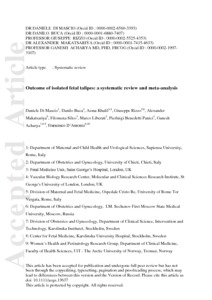Di Mascio, D; Buca, D; Khalil, A; Rizzo, G; Makatsariya, A; Sileo, F; Liberati, M; Benedetti Panici, P; Acharya, G; D'Antonio, F
(2019)
Outcome of isolated fetal talipes: A systematic review and meta‐analysis.
Acta Obstet Gynecol Scand, 98 (11).
pp. 1367-1377.
ISSN 1600-0412
https://doi.org/10.1111/aogs.13637
SGUL Authors: Khalil, Asma
![[img]](https://openaccess.sgul.ac.uk/110849/1.hassmallThumbnailVersion/Mascio_et_al-2019-Acta_Obstetricia_et_Gynecologica_Scandinavica.pdf)  Preview |
|
PDF
Accepted Version
Available under License ["licenses_description_publisher" not defined].
Download (544kB)
| Preview
|
Abstract
Introduction
The aim of this systematic review was to explore the outcome of fetuses with a prenatal diagnosis of isolated talipes.
Material and methods
Medline, Embase, Cinahl, and Clinicaltrials.gov databases were searched. The outcomes explored were: associated anomalies detected at follow‐up ultrasound examination; fetal magnetic resonance imaging (MRI) and birth; chromosomal abnormalities detected with standard and chromosomal microarray analysis, intrauterine, neonatal, and perinatal death, and termination of pregnancy; rate of surgical and nonsurgical treatment; neurodevelopmental outcome; and false‐positive rate of prenatal diagnosis. Meta‐analyses of proportions were used to combine data.
Results
Twenty‐five studies (1567 fetuses) were included. Associated anomalies were detected in 7.8% (95% CI 0.1%‐29.3%) of cases at follow‐up ultrasound, and in 4.0% (95% CI 0.1%‐13.2%) of cases, fetal MRI identified anomalies not detected at ultrasound assessment. Similarly, 7.0% (95% CI 3.4%‐11.7%) of cases labeled as isolated talipes on prenatal imaging were found to have associated anomalies at birth. Abnormal karyotype was present in 3.6% (95% CI 1.7%‐6.2%) of fetuses, whereas no anomaly was found at chromosomal microarray analysis, although this outcome was reported by only 1 study. Intrauterine death occurred in 0.99% (95% CI 0.4%‐1.9%) of fetuses, whereas the corresponding figures for neonatal death and termination of pregnancy were 1.5% (95% CI 0.6%‐2.6%) and 2.2% (95% CI 1.2%‐3.4%), respectively. Surgical management of anomalies after birth was found in 41.7% (95% CI 27.0%‐57.2%) of fetuses with isolated talipes, and 54.8% (95% CI 31.5%‐77.0%) had nonsurgical management of the anomalies after birth. Abnormal neurodevelopmental outcome was reported in 7.6% (95% CI 1.0%‐19.4%) of children, although this analysis was affected by the small number of included cases and short time of follow up.
Conclusions
Isolated talipes detected on prenatal ultrasound carries a generally good prognosis. The incidence of additional abnormalities detected on fetal MRI, aneuploidy, or neurodevelopmental disability is relatively low. However, longitudinal ultrasound assessment during pregnancy and a thorough postnatal evaluation are recommended to rule out associated anomalies that may significantly impact short‐ and long‐term prognosis.
| Item Type: |
Article
|
| Additional Information: |
This is the peer reviewed version of the following article: Di Mascio, D, Buca, D, Khalil, A, et al. Outcome of isolated fetal talipes: A systematic review and meta‐analysis. Acta Obstet Gynecol Scand. 2019; 98: 1367‐ 1377, which has been published in final form at https://doi.org/10.1111/aogs.13637. This article may be used for non-commercial purposes in accordance with Wiley Terms and Conditions for Use of Self-Archived Versions. |
| Keywords: |
Clubfoot, fetal MRI, karyotype, talipes equinovarus ultrasound, 1114 Paediatrics And Reproductive Medicine, 1117 Public Health And Health Services, Obstetrics & Reproductive Medicine |
| SGUL Research Institute / Research Centre: |
Academic Structure > Molecular and Clinical Sciences Research Institute (MCS) |
| Journal or Publication Title: |
Acta Obstet Gynecol Scand |
| ISSN: |
1600-0412 |
| Language: |
eng |
| Dates: |
| Date | Event |
|---|
| 15 October 2019 | Published | | 6 June 2019 | Published Online | | 16 April 2019 | Accepted |
|
| Publisher License: |
Publisher's own licence |
| PubMed ID: |
31034582 |
 |
Go to PubMed abstract |
| URI: |
https://openaccess.sgul.ac.uk/id/eprint/110849 |
| Publisher's version: |
https://doi.org/10.1111/aogs.13637 |
Statistics
Item downloaded times since 02 May 2019.
Actions (login required)
 |
Edit Item |



